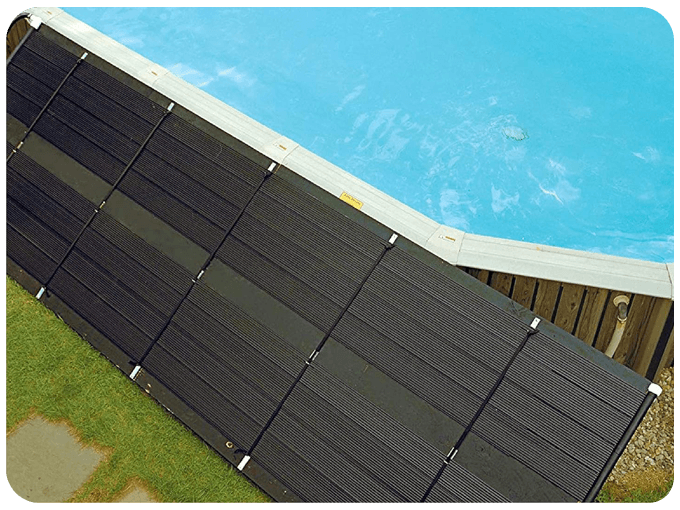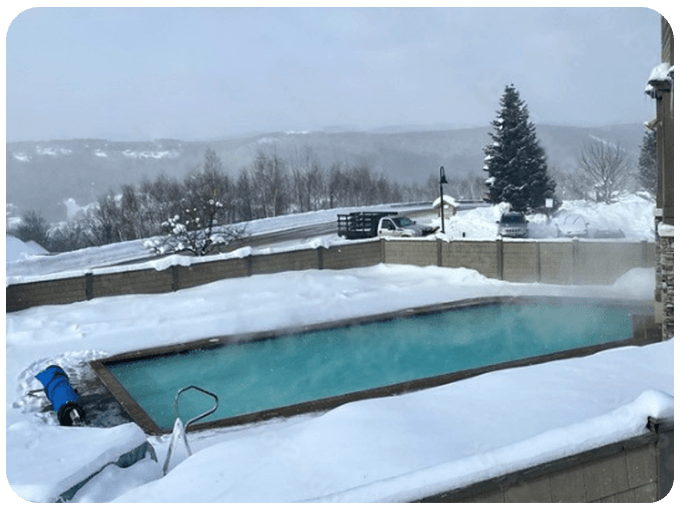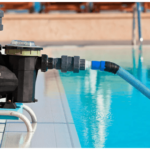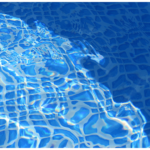Información actualizada April 7, 2024
Proper heating and cooling are fundamental aspects of fully enjoying a pool, especially when it comes to fiberglass pools. In this article, we will explore key technical specifications and answer frequently asked questions so you can make informed decisions on how to maintain the perfect temperature with Heating and Cooling for Fiberglass Pools.
Table of Contents
Introduction to Heating and Cooling for Fiberglass Pools
In the world of fiberglass pools, water temperature is crucial. It’s not just about comfort but also about preserving the structural integrity of the pool and ensuring the safety of swimmers. Let’s delve into why heating and cooling are essential aspects.
The importance of maintaining the right temperature in fiberglass pools lies in the durability of the material and the user’s comfort. Constant exposure to extreme temperatures can affect the integrity of fiberglass material, potentially resulting in costly damage. Moreover, swimming in water at the right temperature significantly enhances the experience, encouraging frequent pool use.
Advantages of Using Specific Systems for Fiberglass Pools
When it comes to heating and cooling for fiberglass pools, system choice is crucial. Opting for solutions tailored to this type of pool offers various benefits that not only benefit the user but also the environment.
- Energy Efficiency
Systems specifically designed for fiberglass pools tend to be more energy-efficient. This translates to lower electricity or fuel consumption, which is not only pocket-friendly for the owner but also eco-friendly.
- Durability and Resistance
Corrosion resistance and durability are inherent characteristics of systems designed for fiberglass pools. These systems are built with the unique properties of this material in mind, prolonging the lifespan of both the system and the pool itself.
- Positive Impact on Water Quality
Maintaining a constant temperature in the pool not only contributes to swimmer comfort but also positively impacts water quality. Extreme temperature fluctuations can promote algae and bacteria growth, affecting water cleanliness and clarity.
Heating Options for Fiberglass Pools
When it comes to heating a fiberglass pool, there are several options to consider. Each has its own features and benefits, so it’s crucial to choose the one that best suits your needs and preferences.
Solar Heating Systems
Solar heating systems are a popular and eco-friendly option. They use solar panels to absorb energy from the sun and heat the pool water. While the initial investment may be higher, these systems are cost-effective in the long run and significantly reduce carbon footprint.
Heat Pumps: Operation and Benefits
Heat pumps are efficient devices that harness thermal energy from the air or water to heat the pool. Although they typically have a lower initial cost than solar systems, they are effective and operate sustainably.
Electric Heaters
Electric heaters are a conventional option that remains effective. These devices use electric resistors to heat the pool water. While they may have higher electricity consumption, their installation and maintenance are more accessible.

Innovative Cooling for Fiberglass Pools
While heating is essential, we must not overlook the importance of cooling, especially in warm climates. High temperatures can negatively affect the swimming experience and, in some cases, swimmers’ health. Let’s explore some innovations in cooling systems for fiberglass pools.
Current Cooling Technologies
Current cooling systems incorporate advanced technologies to maintain pleasant temperatures in warm climates. This may include spray systems, integrated fans, or even the incorporation of reflective materials in the pool design to dissipate heat.
Ventilation Systems
Proper ventilation is key to maintaining freshness in the pool environment. Well-designed ventilation systems can expel accumulated hot air and promote air circulation, creating a more comfortable environment for swimmers.
Importance of Maintaining Optimal Temperatures in Warm Climates
In regions with warm climates, cooling becomes an essential part of pool design. Maintaining optimal temperatures not only improves the user experience but also can have a positive impact on the durability of the pool and its components.
Technical Specifications for Fiberglass Pools
Now that we’ve explored heating and cooling options, it’s crucial to understand the technical specifications that make a fiberglass pool suitable for these systems.
- Material Thickness and Composition
The thickness and specific composition of fiberglass material determine its heat retention capacity and resistance. Ensuring that the pool meets specific standards ensures efficient installation of heating and cooling systems.
- Designs Favoring Thermal Efficiency
Some pool designs are specifically conceived to favor thermal efficiency. Certain shapes and structures can contribute to uniform heat distribution and optimization of cooling systems.
- Preventive Maintenance
Regular maintenance is essential to ensure the continuous performance of heating and cooling systems. Periodic inspections and proper cleaning ensure that all components are in optimal condition.

Tips for Installing Heating and Cooling Systems
Installing heating and cooling systems in fiberglass pools is essential to optimize comfort and extend pool use throughout different seasons of the year. Here are some key tips for effective installation:
-
Needs Assessment:
- Before choosing a system, assess your specific needs. Consider the climate of the area, the frequency of pool use, and temperature preferences to determine if you need heating, cooling, or both.
-
Selecting the Right System:
- Choose the heating or cooling system that best suits your requirements. Options include heat pumps, heat exchangers, solar systems, and evaporative coolers. The choice will depend on factors such as efficiency, budget, and sustainability.
-
Consideration of Energy Efficiency:
- Opt for systems that are energy-efficient. Heat pumps, for example, can be an effective and environmentally friendly option, providing heating without consuming large amounts of energy.
-
Professional Installation:
- The installation of heating and cooling systems should be carried out by qualified professionals. Make sure to hire specialized technicians to ensure proper and safe installation.
-
Integration with Filtration System:
- Ensure that the heating or cooling system is properly integrated with the pool’s filtration system. Good integration will ensure coordinated and efficient operation.
-
Automation and Control:
- Consider incorporating automation and control systems. This will allow you to manage the pool temperature remotely, schedule operation times, and optimize energy efficiency.
-
Complementary Systems:
- Explore options for complementary systems, such as thermal pool covers. These accessories can help retain heat and reduce energy loss, improving the efficiency of heating systems.
-
Pool Enclosure Insulation:
- Ensure that the area surrounding the pool is well insulated. Good insulation will help maintain water temperature, thereby reducing the workload of heating and cooling systems.
-
Regular Maintenance:
- Schedule regular maintenance for installed systems. Cleaning, inspection, and replacement or repair of worn components are essential to maintain efficient performance over time.
-
Environmental Considerations:
- If possible, choose systems that are environmentally friendly. Sustainability is a growing concern, and choosing environmentally friendly technologies can be beneficial in the long run.
By following these tips during the installation of heating and cooling systems, fiberglass pool owners can create a comfortable aquatic environment adaptable to different weather conditions, thus maximizing the enjoyment of their investment.
Pool Size Assessment
The capacity of the heating or cooling system should be proportional to the pool size. A careful assessment ensures that the selected system can efficiently maintain the desired temperature.
Safety Considerations
Safety is paramount when installing heating and cooling systems. Ensuring that components are correctly installed and that safety regulations are followed reduces potential risks and improves the overall experience.
Regular Maintenance and Technical Review
Regular maintenance is key to the longevity and effectiveness of systems. Scheduling periodic technical reviews helps identify and address any potential issues before they affect performance.
Environmental Impact of Heating and Cooling Systems
Sustainability is an increasingly important aspect when choosing heating and cooling systems. Let’s examine how these options can have a positive impact on the environment.
Ecological Alternatives
The search for ecological alternatives is essential today. Opting for systems that use renewable energy sources or minimize resource consumption contributes to environmental conservation.
Reduction of Energy Consumption
Efficient systems not only benefit the owner in terms of costs but also contribute to reducing energy consumption globally. This eco-friendly approach is an important consideration when choosing heating and cooling systems.
Contribution to Sustainability
Contribution to sustainability goes beyond efficient energy use. By choosing durable and resistant systems, the need for frequent replacements is reduced, thus minimizing waste generation.
How to Choose the Right System for Your Fiberglass Pool
With so many options available, choosing the right system can seem overwhelming. Here are some guidelines to help you make the best decision.
Consulting Professionals
Seeking advice from professionals in pool design and maintenance is essential. They can assess your specific needs and recommend the system that best suits your situation.
Comparing Costs and Efficiency
It’s important to find a balance between costs and efficiency. Compare different systems in terms of initial investment, operating costs, and long-term effectiveness to make an informed decision.
User Reviews and Success Stories
Researching the experiences of other users is valuable. Reviews and success stories offer real insights into the effectiveness and durability of heating and cooling systems.
Frequently Asked Questions about Heating and Cooling for Fiberglass Pools
What Is the Ideal Temperature for a Pool?
The ideal temperature for a pool is typically between 77°F and 82°F. However, preferences may vary, and it’s important to adjust the temperature according to your personal preferences.
How Does Heating Affect Energy Consumption?
Heating can increase energy consumption, but choosing efficient systems and moderate use can mitigate this impact. Opting for renewable energy sources is also a sustainable option.


